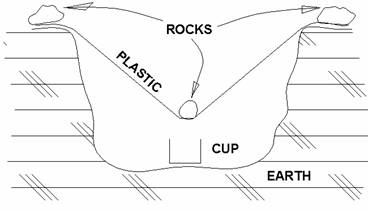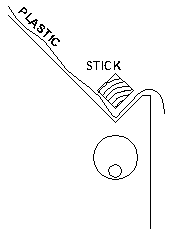
Now when you actually try this
thing you are likely to come up with a little more education than you
had when you thought it was just a neat idea. How do you get the
water out without dismantling the still? How easy is it to
accidentally kick dirt into the cup? How much water do you get in a
24-hour period? How would you like your life to depend upon this
thing if you haven’t tried it first?
Still more
The next illustrations
show a still I built a still out of 5/8” plywood, which leaves
behind most (theoretically all) the minerals and microbes. I say
“most”, because the water tasted like plywood. The water itself
is contained by a plastic lining in the bottom 6” , and does not
come directly in contact with the wood. The still will vaporize and
condense anything that will vaporize and condense at the temperatures
involved; this apparently includes the smell of wood. As a good rule
of thumb, if you can smell it, you’re probably drinking it.
I am sure this could be
over-come by lining the entire inside with plastic. You might also
consider coating the plywood directly with a rubberized roof coating
of some kind (Rubber-scented water might become a novelty).



A flexible sheet of
plastic can be laid upon the sloping portion, and a shin square stick
laid on top of the plastic holds it into the corner at the bottom.
You might also use a rigid piece of glass or plastic, in which case
you need to close the bottom corner with something to keep the water
vapor from escaping.
Door prize (Bad puns are loved only by their creators)
I made a box from a couple
of old doors with scraps of plywood nailed to the ends. I lined this
box with plastic and used a couple of bricks or something to support
a sloping trough down the center of it. This trough was a strip cut
from a piece of fiberglass corrugated roofing, and it protruded out
through a hole in one end where it could drip into a bottle The exit
and bottle were covered with plastic so the water wouldn’t
evaporate before it was stored. The top was covered with excess clear
plastic, with a weight down the center so the water would run into
the trough.
This still worked better
than anything else I tried, was simple and quick to build. The basic
lesson in all this is simply “Look around you, and think.”